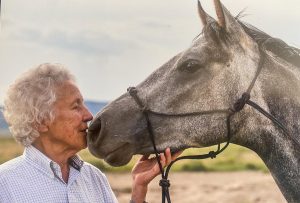CS Ranch Matriarch Leaves Unmatched Legacy
 CIMARRON — While long lists of the accomplishments of Linda Davis, matriarch of the CS Ranch in Cimarron, and of the “firsts” she achieved in her lifetime, fill obituary pages, and will remain as the legacy of a trail breaking Western icon, something simpler and closer to home also needs to be celebrated.
CIMARRON — While long lists of the accomplishments of Linda Davis, matriarch of the CS Ranch in Cimarron, and of the “firsts” she achieved in her lifetime, fill obituary pages, and will remain as the legacy of a trail breaking Western icon, something simpler and closer to home also needs to be celebrated.
When Linda smiled at you, or told you “Good job,” or said she was proud of you, you felt lifted up and held that moment in your heart from then on. She made you a better person. Maybe that’s the kind of influence kings and queens strive for with their ritual and protocol, but Linda achieved her power simply through being who she was – honest, straightforward, a beacon of common sense, respectful, and reliably doing what was right.
Western agriculture, specifically, the beef industry, had no better representative. She did not set out to become a star, rather, the influence she achieved was due to hard work, dedication, and persistence with each job until she could say “got ‘er done” to her own satisfaction, be the task at hand branding cattle, weaning calves, gathering wild asparagus on the ranch, or later in life, serving as Colfax County EMT.
Born July 11, 1930, Davis was raised by a wagon crew on the legendary Bell Ranch in San Miguel County. Her mother, Julia Sundt Mitchell, one of the first traveling nurses in NM, passed away when Linda was only four. So her father, Albert K. Mitchell, brought her from the family’s Tequesquite Ranch in Harding County to the Bell, where he was manager.
In addition to teaching her to read and cook, the cowboys taught her not to cry. “Only girls cry,” they told her.
“My father was the most renowned cattleman of the century,” she says. “Dad felt if I could do anything well, I could compete with anybody.”
“I was one of the crew,” she says. “Dad always treated me like I was his right hand. In addition, I was his hostess, and he liked to have white linen tablecloths on the table at night and real linen napkins. We had a lot of company.” Influential people from politics, academia, finance, art and literature the world over visited the Bell.
Following her education at Cornell, where she studied agricultural economics, she came home before graduation to help her dad out. She said, “Grandmother had lost her sight, Dad had been injured, and my brother was off at school. My dad needed someone to run the ranch, so I came home.”
Linda got to know her husband-to-be, Les Davis, when he returned from serving in WWII. Reared and educated in the east, at Dartmouth College, he felt called to the family ranch.
Following their marriage in 1953, she joined him on his family’s CS Ranch, where a serious drought was in progress. “So I got busy and made a hand on the ranch,” she says.
Founded in 1873 by Les’ grandfather, Frank Springer, the CS is the 13th oldest ranch in the country. It is named for Charles Springer, Frank’s brother, and lawyer for the Maxwell Land Grant Co.
Along with tending to the cattle, Davis helped with the ranch’s horse-breeding program, which was originally established in the 1880s. In 2007, the program earned the American Quarter Horse Association’s Legacy Award for registering American Quarter Horses for more than 50 years.
She made a mark on regional agriculture as a representative to the Cattlemen’s Beef Board, the Beef Promotion Operating Committee, the American National CattleWomen and the New Mexico Beef Council.
In 1995, she was inducted into the National Cowgirl Museum and Hall of Fame.
In 1985, she and other prominent New Mexico ranchers founded the New Mexico Farm and Ranch Heritage Museum in Las Cruces. She was the first secretary.
“I built my career in agriculture while also serving as an emergency medical technician and raising six children, which is something I’m especially proud of,” she said. Five of her six children remain involved with the operation of the ranch.
Recently, she was honored with the highest recognition from the National Cowboy and Western Heritage Museum, an award so prestigious it is not given every year. She was also a charter member of the Annie Oakley Society.




